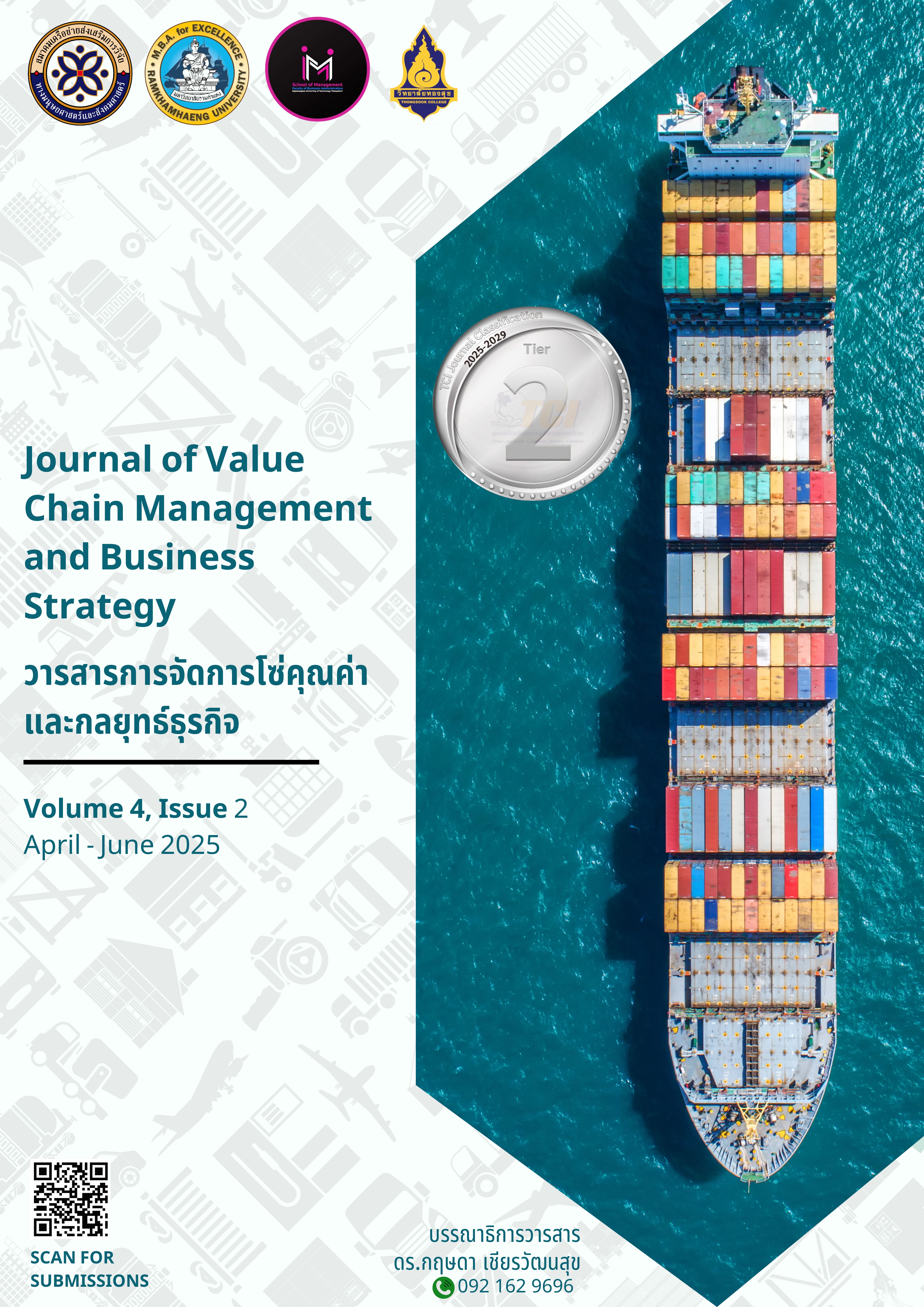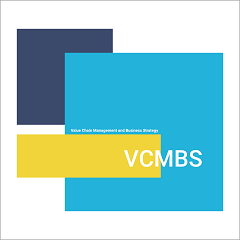อิทธิพลของทัศนคติและวัฒนธรรมองค์การที่มีต่อแรงจูงใจ และสมรรถนะการสื่อสารภาษาอังกฤษของพนักงานไทย
คำสำคัญ:
ทัศนคติต่อการสื่อสารภาษาอังกฤษ, วัฒนธรรมองค์การ, แรงจูงใจในการสื่อสารภาษาอังกฤษ, สมรรถนะการสื่อสารภาษาอังกฤษบทคัดย่อ
การวิจัยครั้งนี้มีวัตถุประสงค์เพื่อศึกษาอิทธิพลของทัศนคติและเป็นวัฒนธรรมองค์การที่มีต่อแรงจูงใจและสมรรถนะการสื่อสารภาษาอังกฤษของพนักงานไทย การวิจัยเรื่องนี้การวิจัยเชิงปริมาณ ใช้วิธีการสำรวจโดยใช้แบบสอบถามเป็นเครื่องมือในการเก็บข้อมูล กลุ่มตัวอย่าง คือ พนักงานในบริษัทเอกชนในกรุงเทพมหานครและปริมณฑล จำนวน 385 คน สถิติเชิงพรรณนาที่ใช้ในการวิเคราะห์ข้อมูลเชิงปริมาณ ได้แก่ ค่าความถี่ ค่าร้อยละ ค่าเฉลี่ยและค่าส่วนเบี่ยงเบนมาตรฐาน สถิติเชิงอนุมานที่ใช้ในการทดสอบสมมติฐาน คือ ค่าสัมประสิทธิ์สหสัมพันธ์แบบเพียร์สัน และการวิเคราะห์ในรูปแบบของโมเดลสมการโครงสร้างแบบกำลังสองน้อยที่สุดบางส่วน (PLS-SEM)
ผลการวิจัยพบว่า ทัศนคติของพนักงานต่อการสื่อสารภาษาอังกฤษมีอิทธิพลทางตรงเชิงบวกต่อสมรรถนะการสื่อสารภาษาอังกฤษอย่างมีนัยสำคัญทางสถิติที่ระดับ .001 วัฒนธรรมองค์การไม่มีอิทธิพลทางตรงต่อสมรรถนะการสื่อสารภาษาอังกฤษ (p-value = .214) แต่มีอิทธิพลทางตรงต่อแรงจูงใจในการใช้ภาษาอังกฤษอย่างมีนัยสำคัญทางสถิติที่ระดับ .001 ทั้งแรงจูงใจในการใช้ภาษาอังกฤษและทัศนคติของพนักงานมีความสัมพันธ์เชิงบวกอย่างมีนัยสำคัญทางสถิติที่ระดับ .001 การวิเคราะห์อิทธิพลทางอ้อมพบว่า แรงจูงใจเป็นตัวแปรส่งผ่านบางส่วนระหว่างทัศนคติกับสมรรถนะการสื่อสารภาษาอังกฤษ และเป็นตัวแปรส่งผ่านแบบสมบูรณ์ระหว่างวัฒนธรรมองค์การกับสมรรถนะการสื่อสารภาษาอังกฤษ ผลการศึกษานี้ชี้ให้เห็นว่า การพัฒนาสมรรถนะการสื่อสารภาษาอังกฤษของพนักงานควรมุ่งเน้นการสร้างแรงจูงใจควบคู่กับการพัฒนาทัศนคติและวัฒนธรรมองค์การที่เอื้อต่อการใช้ภาษาอังกฤษ โดยเฉพาะเมื่อพิจารณาว่าวัฒนธรรมองค์การส่งผลต่อสมรรถนะการสื่อสารภาษาอังกฤษผ่านแรงจูงใจเท่านั้น
เอกสารอ้างอิง
Bagozzi, R. P., & Yi, Y. (1988). On the evaluation of structural equation models. Journal of the Academy of Marketing Science, 16(1), 74-94. https://doi.org/10.1007/BF02723327
Bagozzi, R. P., & Yi, Y. (2012). Specification, evaluation, and interpretation of structural equation models. Journal of the Academy of Marketing Science, 40(1), 8-34. https://doi.org/10.1007/s11747-011-0278-x
Bank of Thailand. (2023). Economic overview and language requirements in the Thai private sector. https://www.bot.or.th
Baron, R. M., & Kenny, D. A. (1986). The moderator–mediator variable distinction in social psychological research: Conceptual, strategic, and statistical considerations. Journal of Personality and Social Psychology, 51(6), 1173–1182. https://doi.org/10.1037//0022-3514.51.6.1173
Bolton, K., & Bacon-Shone, J. (2020). The statistics of English across Asia. In K. Bolton, W. Botha., & A. Kirkpatrick (Eds.), The Handbook of Asian Englishes (pp. 49-80). https://doi.org/10.1002/9781118791882.ch3
Bücker, J. J., Furrer, O., Poutsma, E., & Buyens, D. (2014). The impact of cultural intelligence on communication effectiveness, job satisfaction and anxiety for Chinese host country managers working for foreign multinationals. The International Journal of Human Resource Management, 25(14), 2068-2087. https://doi.org/10.1080/09585192.2013.870291
Cochran, W. (1953). Sampling techniques. John Wiley & Sons. Inc.
Crystal, D. (2003). English as a global language (2nd ed.). Cambridge University Press. https://doi.org/10.1017/CBO9780511486999
Dewaele, J. M. (2019). The effect of classroom emotions, attitudes toward English, and teacher behavior on willingness to communicate among English foreign language learners. Journal of Language and Social Psychology, 38(4), 523-535. https://doi.org/10.1177/0261927X19864996
Dewaele, J. M., Witney, J., Saito, K., & Dewaele, L. (2018). Foreign language enjoyment and anxiety: The effect of teacher and learner variables. Language Teaching Research, 22(6), 676-697. https://doi.org/10.1177/1362168817692161
Dörnyei, Z. (2005). The psychology of the language learner: Individual differences in second language acquisition. Lawrence Erlbaum Associates.
Dörnyei, Z., & Al‐Hoorie, A. H. (2017). The motivational foundation of learning languages other than global English: Theoretical issues and research directions. The Modern Language Journal, 101(3), 455-468. https://doi.org/10.1111/modl.12408
Dörnyei, Z., & Ushioda, E. (2021). Teaching and researching motivation. Routledge.
EF Education First. (2018). EF English Proficiency Index 2018. https://www.ef.com/assetscdn/WIBIwq6RdJvcD9bc8RMd/cefcom-epi-site/reports/2018/ef-epi-2018-english.pdf
EF Education First. (2019). EF English Proficiency Index 2019. https://www.ef.com/assetscdn/WIBIwq6RdJvcD9bc8RMd/cefcom-epi-site/reports/2019/ef-epi-2019-english.pdf
EF Education First. (2023). EF English Proficiency Index 2023. https://www.ef.com/assetscdn/WIBIwq6RdJvcD9bc8RMd/cefcom-epi-site/reports/2023/ef-epi-2023-english.pdf
Fornell, C., & Larcker, D. F. (1981). Structural equation models with unobservable variables and measurement error: Algebra and statistics. Journal of Marketing Research, 18(3), 382–388. https://doi.org/10.1177/002224378101800313
Gardner, R. C. (1985). Social psychology and second language learning: The role of attitudes and motivation. Edward Arnold.
Gardner, R. C. (2001). Integrative motivation and second language acquisition. In Z. Dornyei, & R. Schmidt (Eds.), Motivation and Second Language Acquisition (1-20). Honolulu Publishing Company Ltd.
Hajiar, S. T. (2014). A statistical study to develop a reliable scale to evaluate instructors within higher institution. WSEAS Transactions on Mathematics, 13, 885–894.
Henderson, J. K. (2005). Language diversity in international management teams. International Studies of Management & Organization, 35(1), 66-82. https://doi.org/10.1080/00208825.2005.11043722
Hofstede, G. (1991). Cultures and organizations: Software of the mind. McGraw-Hill.
Husin, M. S., Ibrahim, R., de Mello, G., & Ariffin, K. (2023). Perceptions on English communication skills training for hotel front office employees. European Proceedings of Educational Sciences, 7, 773-782. https://doi.org/10.15405/epes.23097.69
Jenkins, J. (2015). Repositioning English and multilingualism in English as a Lingua Franca. Englishes in Practice, 2(3), 49-85. https://doi.org/10.1515/eip-2015-0003
Kim, S., & McLean, G. N. (2014). The impact of national culture on informal learning in the workplace. Adult Education Quarterly, 64(1), 39-59. https://doi.org/10.1177/0741713613504125
Kirkpatrick, A. (2020). English as a lingua franca in ASEAN: A multilingual model. Hong Kong University Press.
Li, C. (2021). A control–value theory approach to boredom in English classes among university students in China. The Modern Language Journal, 105(1), 317-334. https://doi.org/10.1111/modl.12693
Lynn, M. R. (1986). Determination and quantification of content validity. Nursing Research, 35(6), 382–385. https://doi.org/10.1097/00006199-198611000-00017
Ma, Y. (2022). Role of communication strategies in organizational commitment, mediating role of faculty engagement: Evidence from English language teachers. Frontiers in Psychology, 13, 921797. https://doi.org/10.3389/fpsyg.2022.921797
MacIntyre, P. (2020). Expanding the theoretical base for the dynamics of willingness to communicate. Studies in Second Language Learning and Teaching, 10(1), 111-131. https://doi.org/10.14746/ssllt.2020.10.1.6
MacIntyre, P. D., Gregersen, T., & Mercer, S. (2020). Language teachers’ coping strategies during the Covid-19 conversion to online teaching: Correlations with stress, wellbeing and negative emotions. System, 94, 102352. https://doi.org/10.1016/j.system.2020.102352
Neeley, T. (2017). The language of global success: How a common tongue transforms multinational organizations. In The Language of Global Success. Princeton University Press.
Nhi, N. T., & Son, N. T. (2025). The effects of organizational culture on employee motivation – A case study in Vietnam. Journal of Ecohumanism, 3(8), 11439–11449. https://doi.org/10.62754/joe.v3i8.5743
Noe, R. A. (2020). Employee training and development (8th ed.). McGraw-Hill Education.
Nunnally, J. C., & Bernstein, I. H. (1994). Psychometric theory. McGraw-Hill.
Oletić, A., & Ilić, N. (2014). Intrinsic and extrinsic motivation for learning English as a foreign language. Elta Journal, 2(2), 23-38.
Peiró, J. M., Nielsen, K., Latorre, F., Shepherd, R., & Vignoli, M. (2020). Safety training for migrant workers in the construction industry: A systematic review and future research agenda. Journal of Occupational Health Psychology, 25(4), 275–295. https://doi.org/10.1037/ocp0000178
Peterson, R. A. (2000). A meta-analysis of variance accounted for and factor loadings in exploratory factor analysis. Marketing Letters, 11, 261-275. https://doi.org/10.1023/A:1008191211004
Piekkari, R., Welch, D., & Welch, L. S. (2014). Language in international business: The multilingual reality of global business expansion. Edward Elgar Publishing.
Ramadanty, S., & Martinus, H. (2016). Organizational communication: Communication and motivation in the workplace. Humaniora, 7(1), 77-86. https://doi.org/10.21512/humaniora.v7i1.3490
Rao, Z. (2016). Language learning strategies and English proficiency: Interpretations from information-processing theory. The Language Learning Journal, 44(1), 90-106. https://doi.org/10.1080/09571736.2012.733886
Raoofi, S., Tan, B. H., & Chan, S. H. (2012). Self-efficacy in second/foreign language learning contexts. English Language Teaching, 5(11), 60-73. https://doi.org/10.5539/elt.v5n11p60
Rayah, R. A., Jafre, N. A. M., Husain, N. A., & Nawawi, W. R. W. M. (2018). Attitude and motivation in spoken English among semester 4 students in a Malaysian Polytechnic-a correlational study. Jurnal EDUCATIO: Jurnal Pendidikan Indonesia, 4(2), 100-107. http://dx.doi.org/10.29210/120182256
Reiche, B. S., Harzing, A. W., & Pudelko, M. (2017). Why and how does shared language affect subsidiary knowledge inflows? A social identity perspective. In Language in International Business: Developing a Field (pp. 209-253). Cham: Springer International Publishing. https://doi.org/10.1007/978-3-319-42745-4_9
Santos, T., Santos, E., Sousa, M., & Oliveira, M. (2024). The mediating effect of motivation between internal communication and job satisfaction. Administrative Sciences, 14(4), 69. https://doi.org/10.3390/admsci14040069
Schein, E. H. (2004). Organizational culture and leadership (3rd ed.). Jossey-Bass.
Sugiono, E., & Prastowo, H. (2021). The influence of organizational culture, competence and motivation on employee performance and its impact on organizational performance in information and communication technology security services. Influence: International Journal of Science Review, 3(3), 17–33. https://doi.org/ 10.54783/influence.v3i3.153.
Tenzer, H., & Pudelko, M. (2017). The influence of language differences on power dynamics in multinational teams. Journal of World Business, 52(1), 45-61. https://doi.org/10.1016/j.jwb.2016.11.002
Tippins, M. J., & Sohi, R. S. (2003). IT competency and firm performance: Is organizational learning a missing link? Strategic Management Journal, 24(8), 745-761. https://doi.org/10.1002/smj.337
Toomnan, P., & Intaraprasert, C. (2015). The impacts of attitude towards speaking English on the use of communication strategies by English majors in Thailand. Theory and Practice in Language Studies, 5(6), 1151-1158. https://doi.org/10.17507/tpls.0506.04
Wang, Y., Derakhshan, A., & Zhang, L. J. (2021). Researching and practicing positive psychology in second/foreign language learning and teaching: The past, current status and future directions. Frontiers in Psychology, 12, 731721. https://doi.org/10.3389/fpsyg.2021.731721
Wiriyachitra, A. (2002). English language teaching and learning in Thailand in this decade. Thai TESOL Focus, 15(1), 4-9.
Yamao, S., & Sekiguchi, T. (2015). Employee commitment to corporate globalization: The role of English language proficiency and human resource practices. Journal of World Business, 50(1), 168-179. https://doi.org/10.1016/j.jwb.2014.03.001
Yashima, T. (2002). Willingness to communicate in a second language: The Japanese EFL context. The Modern Language Journal, 86(1), 54–66. https://doi.org/10.1111/1540-4781.00136
ดาวน์โหลด
เผยแพร่แล้ว
รูปแบบการอ้างอิง
ฉบับ
ประเภทบทความ
สัญญาอนุญาต
ลิขสิทธิ์ (c) 2025 วารสารการจัดการโซ่คุณค่าและกลยุทธ์ธุรกิจ

อนุญาตภายใต้เงื่อนไข Creative Commons Attribution-NonCommercial-NoDerivatives 4.0 International License.




